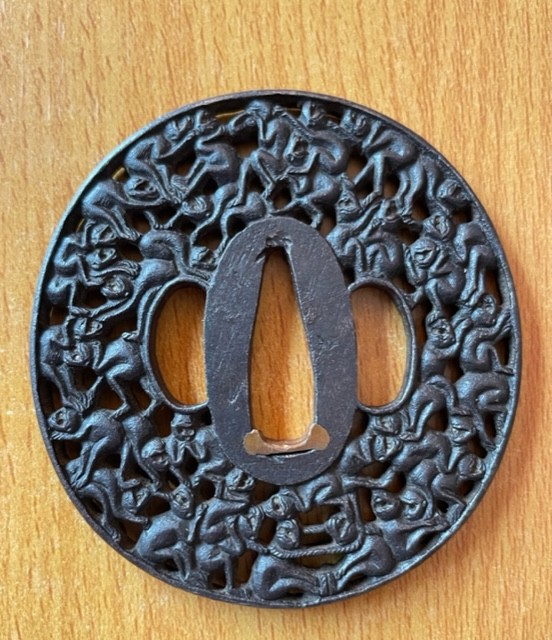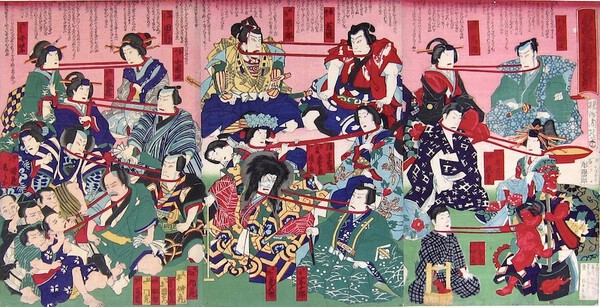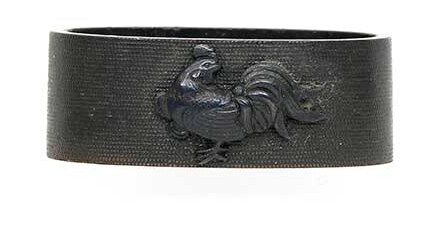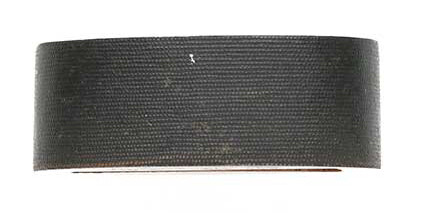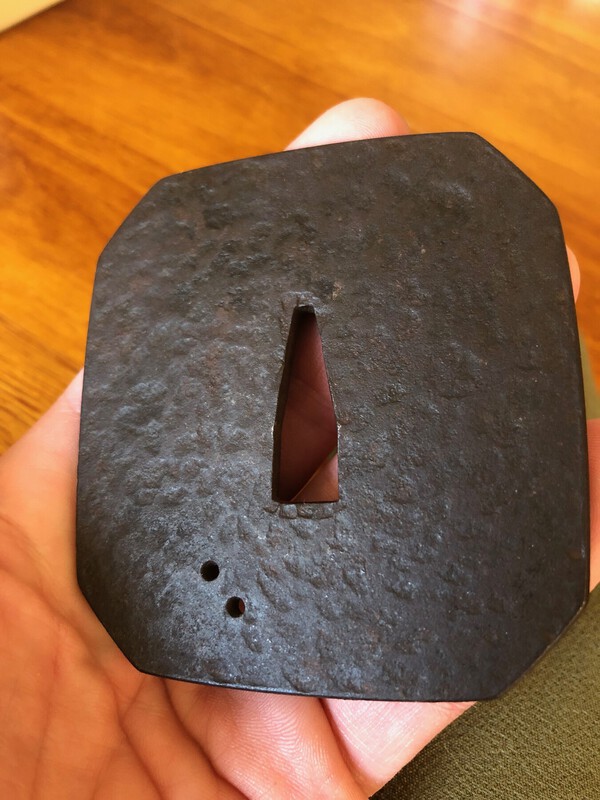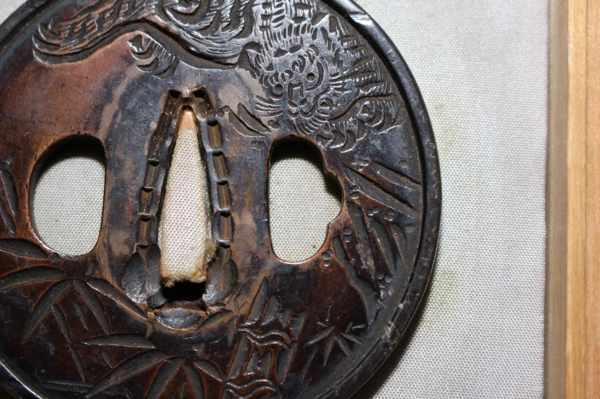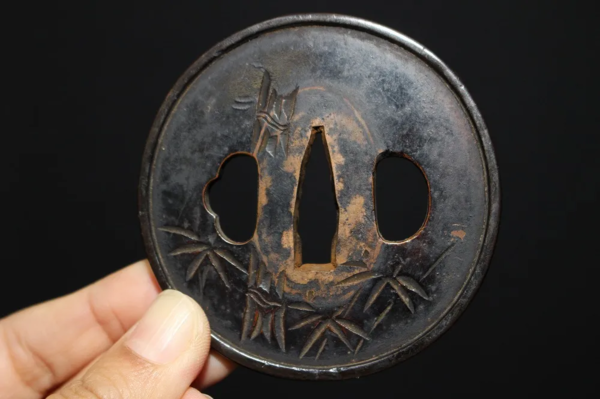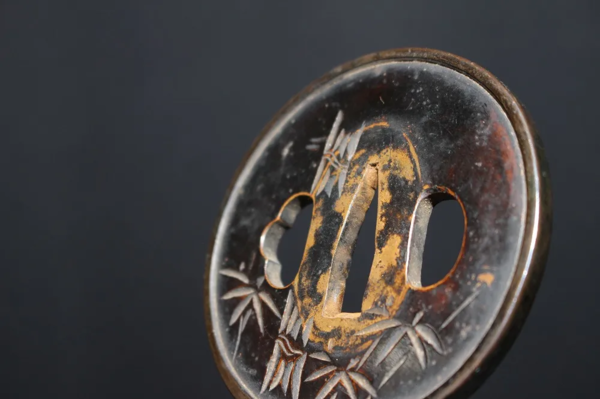Search the Community
Showing results for tags 'tosogu'.
-
Hello all, This might belong under Tosogu, administrator's choie. Looks like two blossoms with 12 petals... any thoughs?
-
Two new additions to my collection. Both in the Thousand Monkeys or senbiki-zaru theme. The second tsuba seems to be a nicer example of the theme. Both tsuba are about 70 mm (2.8 inches) in diameter. The first one has a single hitsu-ana and is heavier. It doesen't show well in the photos, but all of the spaces between the monkeys is openwork. The second had two hitsu-ana and the eyes of the monkeys seem to have been accented in gold, but you have to look really closely to see it. The second one also has monkeys at the bottom that are playing a neck wrestling game called kunipiki. Kunipiki was a game where the opponents would put a loop of rope around their necks and then try to pull the other person over. I have found these examples online: Both tsuba also seem to have monkeys that are of the "See No, Speak No, and Hear No" variety.
-
Afternoon gentlemen and women! I usually stay away from fittings as I lack experience in them, but I saw these in a German auction and picked all three up for 200 Euro. Call it a salve for not getting what I was really after in that auction. How'd I do? I thought at that price, I couldn't get burned much. And if I did, its an acceptable loss for what I got. I'd like to know what their motifs and apparent age are likely to be. I know that the solid brass(?) one is depicting Mt. Fuji and that's about it!
-
Hello Group! My reading of the mei on this fuchi is 吉川 宗光 Yoshikawa Munemitsu. Is this correct? This goes along with my chicken menuki that I posted the origami for earlier this week. The kashira is the chicken's eggs. Thanks!
-
Hello group! If i might beg the indulgence of anyone willing to help me with a translation again... I don't have these in my possession yet, but I am working on the translation of the origami for them. This is a set of menuki with a Hozon paper. They are shakudo chicken menuki. There are five characters (marked with ?) that I really don't have a clue about. The rest was sorted our via process of elimination, and trail and error with the kanji pages and Google Translate. This is what I have so far. Please help me with the missing information and please correct any errors that I may have made. Many thanks in advance! 鑑 定 書 * Kanteisho (Certificate of Appraisal) 一鶏図 目貫 *Hitosu (item) – Niwatori (chicken) – Zu (theme) Menuki 無銘 伝乗 赤銅地 ?? ??? *Mumei (unsigned) Denjo (attributed to the Denjo School) Shakudōji (bronze) ?? ??? 右は當協會に於て審査の結果保存刀装具と鑑定しこれを証する * Migi wa Atari kyōkai ni 於Te shinsa no kekka hozon tôsôgu to kantei shi kore o shōsuru (Examination by this organisation has resulted in the decision that the item to the right is a tosogu that is worthy of preservation (Rank = Hozon)) 平成十六年 二月 二十四日 * Heisei Jū-rokû (16) Nen (year) – Ni (2) Gatsu (month) - Ni-jû-yon (24) Nichi (day) (The 16th Year of Heisei, 2nd Month, 24th Day or February 24, 2004) 財團法人 日本美術刀剣保存協會 * Zaidan Hojin Nihon Bijutsu Token Hozon Kyokai (Financial Incorporated Foundation Japanese Art Swords Preservation Association (NBTHK))
- 6 replies
-
- menuki
- translation
-
(and 1 more)
Tagged with:
-
Dear all, I bought this tsuba a while ago. It has a nice bonji carved on it and I like it. It was dated by the seller as end of Edo but I rather think that it is a modern one. I am not a tsuba guy, I really don't know what to think about it and I need your help on this one.
-
Dear all I have recently acquired a NBTHK Tokubetsu Hozon Yoshiro Zogan tsuba signed, as per NBTHK paper, "Hiroshima Ju Ginza Chosuke". According to the seller the signature is "Hiroshima Ju GINYA Chosuke". I was not able to find any reference or information about the "Ginza Chosuke", but some about the "Ginya Chosuke" on the Kinko Jiten by Wakamatsu Homatsu. A rough translation of it is (please pitch in if you have a better one): Chosuke Living in Nagasaki, Japan. Named Ginya Chosuke, carved in brass flat inlay on a round iron base in Yoshiro Zogan style. Early Edo period. So this "Ginya Chosuke" seems to be spot on for the tsuba. style However I would like to hear your opinion about the NBTHK and seller attribution. If any of you have information about "Ginza Chosuke" or additional information about "Ginya Chosuke" that you care to share I would be grateful. Best Regards Luca
- 4 replies
-
- 3
-

-
- tsuba
- translation
-
(and 1 more)
Tagged with:
-
To (only) people who know what they're talking about: I am currently getting fittings together for my katana in shirasaya. I recently purchased a tsuba from the ebay seller Koushuya. This was after almost a year of searching for the tsuba that felt just right. I ended up going with this one, and I am very happy with the purchase. Apparently it's an antique from the Edo period. But I don't really care about that. I just really like how it looks.......makes me feel good. My first question: Should I leave this thing alone and fit it to my katana as is, or should I do something about the rust that looks like it might be eating away at the sukashi? My second question: If I should do something about the rust, what should I do/how should I do it? I don't want to damage/alter this thing (beyond necessarily removing rust) if I can help it. I really like it. Here are some pics:
- 19 replies



.thumb.jpeg.904689ab1fe7b5d81cfbb59417413ca0.jpeg)
.thumb.jpeg.d9ec8025be8f7867c49d14cf0bfd5021.jpeg)
